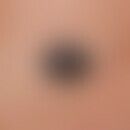HistoryThis section has been translated automatically.
In 2012, Boisson et al. (2012) described three children who developed very early recurrent fever episodes with a strong acute phase reaction, hepatosplenomegaly and lymphadenopathy. Serositis or inflammatory dermatoses, which are usually found in autoinflammatory diseases, were absent. All children were abnormally susceptible to bacterial infections, two out of three also to viral infections. The polysaccharide response to Pneumovax® was impaired. The overall clinical picture was thus characterized by immunodeficiency and autoinflammation. In addition, all three children had amylopectin-like intracellular deposits in the heart, smooth and skeletal muscles, which in combination defined a new clinical picture.
DefinitionThis section has been translated automatically.
HOIL-1 deficiency is an autosomal recessive disease caused by mutations in the HOIL1 gene, which encodes HOIL1, a component of the linear ubiquitination chain assembly complex (LUBAC). These mutations lead to destabilization of the LUBAC complex with impaired IL-1β-dependent NF-κB activation in fibroblasts. However, myeloid cells, especially monocytes, are hyperreactive to IL-1β. Therefore, the consequences of human HOIL-1 and LUBAC deficiency for IL-1β responses differ between cell types
You might also be interested in
EtiopathogenesisThis section has been translated automatically.
Mutations in the RBCK1 gene have been identified as the genetic cause. The encoded enzyme HOIL-1 is a component of LUBAC (linear ubiquitin chain assembly complex). The LUBAC complex in turn is necessary for the linear attachment of ubiquitin molecules to intracellular proteins such as NEMO. Ubiquitination, in turn, is a prerequisite for proteasomal degradation or translocation of proteins, for example, but also for protein-protein interactions.
ClinicThis section has been translated automatically.
Clinically, HOIL-1 deficiency is characterized by early-onset, recurrent febrile episodes with gastrointestinal symptoms such as abdominal pain, vomiting and diarrhea with blood and mucus, as well as lymphadenopathy, respiratory distress, failure to thrive and muscular amylopectinosis (storage of abnormal glycogen leading to intracellular glycogen inclusions) complicated by myopathy and cardiomyopathy. Recurrent bacterial infections associated with immunodeficiency have been reported, including hyper-IgA syndrome and B-cell memory defects with deficient antibody production and impaired response to vaccines. Inflammatory symptoms are accompanied by increased acute phase reactants during relapses (Aksentijevich I et al. 2017).
Dermatologic manifestations: Eczematous lesions, erythroderma and exfoliative dermatitis occurred in various patients with HOIL-1 deficiency. Vaccine-induced subcutaneous inflammatory lesions have also been described (Aksentijevich I et al. 2017; Boisson B et al. 2012).
LiteratureThis section has been translated automatically.
- Aksentijevich I et al. (2017) NF-κB pathway in autoinflammatory diseases: dysregulation of protein modifications by ubiquitin defines a new category of autoinflammatory diseases. Front Immunol 8:399.
- Boisson B et al. (2012) Immunodeficiency, autoinflammation and amylopectinosis in humans with inherite HOIL-1 and LUBAC deficiency. Nat Immunol 13):1178-1186
- Elton L et al. (2015) The multifaceted role of the E3 ubiquitin ligase HOIL-1: beyond linear ubiquitination. Immunol Rev 266:208-221.
- Gerlach B et al. (2011) Linear ubiquitination prevents inflammation and regulates immune signaling. Nature 471:591-596.
- Noad J et al. (2017) LUBAC-synthesized linear ubiquitin chains restrict cytosol-invading bacteria by activating autophagy and NF-κB. Nat Microbiol 2:17063.
Outgoing links (1)
RBCK1 gene;Disclaimer
Please ask your physician for a reliable diagnosis. This website is only meant as a reference.




